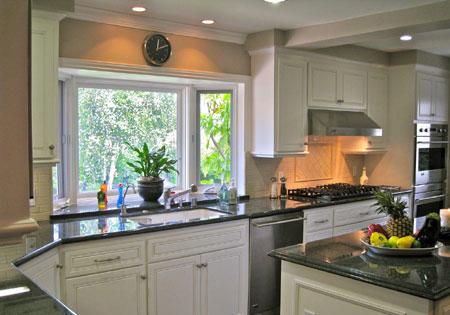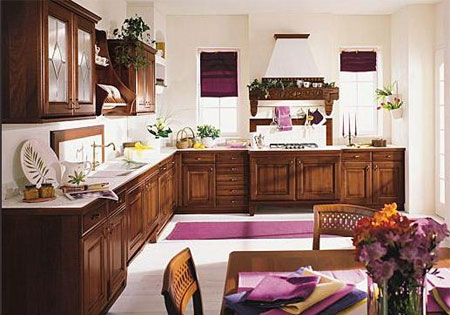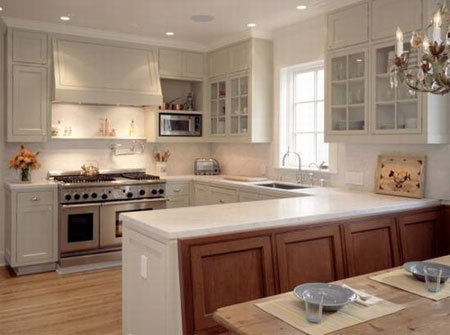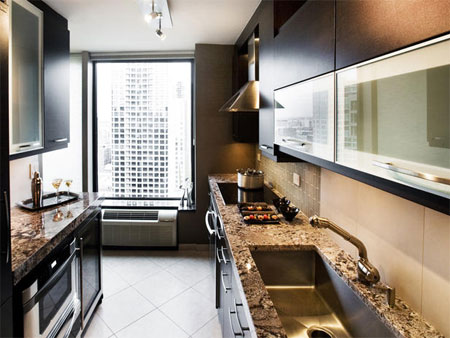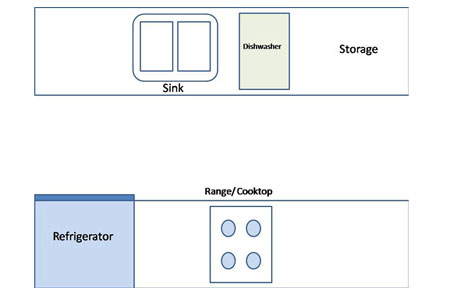What is a kitchen layout plan?
A kitchen layout or plan is something that not all people have complete control over. Unless you plan on remodelling your entire kitchen, knocking down walls, or extending your home, you must work within the confines of a given space.
Kitchen designers have in the past used the triangle principle when formulating a plan for kitchen design. This triangle principle views the sink, cooktops and refrigerator in the form a triangle. However, more efficient kitchen designs are now available and the triangle principle is not used quite as often.
Most efficiency experts suggest having counter space on either side of both the cooktop and sink. There are four basic layouts (shown right) that accommodate the triangle principle.
Island Layout
The island setup is only possible in kitchens that have ample room. When you set up an island, you must be sure to leave enough room on all sides of the island.
Some islands provide additional counter space and seating, and many of them even feature cooktops, stoves, or sinks. Islands with cooktops are the most efficient, because they facilitate shorter triangles. Islands become not only areas on which to work but also places for socializing.
Bar seating underneath hanging lights with dim control make people feel comfortable and relaxed. It becomes the ideal spot for wine and cocktails.
L-Shaped Layout
An L-shaped layout looks exactly how it sounds. Two perpendicular countertops form an L-shaped workspace. Along the L, a sink, stovetop, and refrigerator form a triangle. This is often the most efficient layout possible, because the majority of food preparation can take place in the corner of a kitchen.
The cook does not have to worry about people bumping into him or her, and the other people in the house do not have to purposely avoid the cook.
U-Shaped Layout
Small kitchens often lack the counter space that some cooks need. Hence, you can add an additional countertop to an L layout and form a U. This gives cooks plenty of room with which to work. However, some people begin to feel claustrophobic when surrounded by worktables on all sides.
Triangles fit perfectly in U-shaped kitchens. Because there are three countertops, each of the three major appliances will reside on their own. Cooks operating in a U will rarely have to deal with people trying to pass in front of them while they work.
Corridor Layout
Small townhouses often feature these kitchens to free up living space in other rooms. The sink is usually located along the same wall as the oven, and the refrigerator will be situated along a parallel wall. It's called a corridor kitchen because of its narrowness.
Most corridor kitchens are no greater than 1.5 meters in width. When standing at the stove, the opposite wall is right behind you. Triangles in corridor kitchens usually have short perimeters, as there is limited room to work with.
When planning one of these rooms, make sure to allow enough space for two people. Oftentimes, one person will be using the kitchen while someone else tries to pass by. If possible, avoid situating the major appliances directly opposite one another. This would cause cramming in the event that two people wanted to use two things at the same time.
Drawing a Layout
Drawing a basic layout can make the kitchen remodelling process much simpler. Start off by jotting down the dimensions of your kitchen on a piece of graph paper. The first step is to draw the walls, windows, and doors.
Sketch your empty kitchen on graph paper, indicating doors and windows. The graph paper makes it possible to draw the room according to scale.
After you have the dimensions on paper, you can start playing around with different cupboard and appliance layouts. As you discover items that fit your tastes and needs, use a pencil to draw them onto your blank kitchen layout. Draw lightly, as most people end up experimenting with various setups before deciding what they like. In other words, have an eraser handy.
When sketching your dream kitchen, always think about the work triangle, the space needed for kitchen traffic, and how much room you'll need between tables and walls. After making a rough draft, consider whether or not the setup you have sketched will require rearranging counters, adding electrical outlets, changing the plumbing, etc. If the work and money are not worth it to you, try to incorporate as many aspects of your dream kitchen into your draft as possible without making structural alterations.
Drawing a layout will help you see the potential of your kitchen. Like an artist with a blank canvas, you will have the ability to imagine the design and decorating scheme of your dreams.


